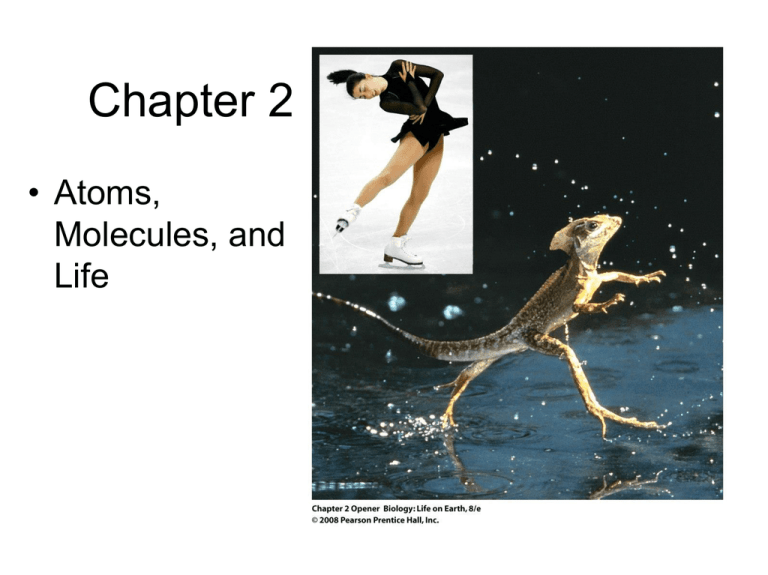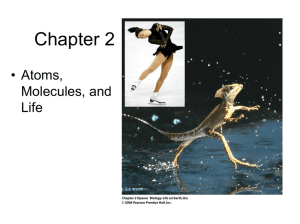
Chapter 2
• Atoms,
Molecules, and
Life
2.1 What Are Atoms?
• Atoms are the basic structural units of
matter. They are composed of still
smaller particles:
– protons (+) in nucleus
– neutrons (uncharged) in nucleus
– electrons (-) in orbitals or electron shells
Copyright © 2005 Pearson Prentice Hall, Inc.
Copyright © 2005 Pearson Prentice Hall, Inc.
• Atomic number = number of protons in
the nucleus
Copyright © 2005 Pearson Prentice Hall, Inc.
Atoms and Elements
• Atoms are electrically neutral because
they have an equal number of positive
protons as negative electrons
• Atoms of an element may vary in the
number of neutrons they have in the
nucleus isotopes (Some radioactive)
Copyright © 2005 Pearson Prentice Hall, Inc.
detector ring
–Figure E2.1 How positron emission tomography works (p.23)
Electron Shells
• Electrons Orbit the Nucleus at Fixed
Distances, Forming Electron Shells That
Correspond to Different Energy Levels
(outer orbitals with more energy)
– The first shell or energy level holds 2
electrons
– The second shell holds up to 8
Copyright © 2005 Pearson Prentice Hall, Inc.
Energy can move
electrons
– Energy exciting an atom causes an electron
jump from a lower- to higher-energy shell
– Later, the electron falls back into its original
shell, releasing the energy
Copyright © 2005 Pearson Prentice Hall, Inc.
– The nucleus provides stability
– The electrons interact with other atoms (e.g.
form bonds)
2e–
5e–
4e–
6e–
2e–
2e–
2e–
6p+
6n
8p+
8n
15p+
8e–
8e–
16n
Carbon
(C)
Oxygen (O)
Copyright © 2005 Pearson Prentice Hall, Inc.Phosphorus (P)
20p+
20n
Calcium (Ca)
• Rules for Interaction:
– Tendency of atoms to have same number of protons
and electrons
– Octet rule: tendency to have 8 electrons in the outer
orbital (except for the first orbital)
2e–
5e–
4e–
6e–
2e–
2e–
2e–
6p+
6n
8p+
8n
15p+
8e–
8e–
16n
Carbon
(C)
Oxygen (O)
Copyright © 2005 Pearson Prentice Hall, Inc.Phosphorus (P)
20p+
20n
Calcium (Ca)
Atoms Interact through
electron shell interactions
• Molecules are made of two or more
atoms. If the atoms are from different
elements the substance is a compound
• There are 3 types of interactions:
– Ionic
– Covalent
– Hydrogen bond
Copyright © 2005 Pearson Prentice Hall, Inc.
How Do Atoms Interact to
Form Molecules?
• 2.2.1 Atoms Interact
with Other Atoms
When There Are
Vacancies in Their
Outermost Electron
Shells
• 2.2.2 Charged
Atoms Called Ions
Interact to Form
Ionic Bonds
– Figure 2.3
Copyright © 2005 Pearson Prentice Hall, Inc.
Na
Sodium atom (neutral)
11p+
11n
Cl
Chlorine atom (neutral)
17p+
18n
Na+
Cl–
Sodium ion (+)
Chloride ion (–)
11p+
11n
17p+
18n
Na+
Cl–
An ionic compound: NaCl
Nonpolar covalent bonding
Hydrogen (H–H or H2)
8p+
8n
8p+
8n
Oxygen (O=O or O2)
Nonpolar covalent bonding
Polar covalent bonding
(slightly negative)
Hydrogen (H–H or H2)
8p+
8n
(slightly positive)
8p+
8n
Oxygen (O=O or O2)
8p+
8n
Water (H–O–H or H2O)
Polar covalent bonding
(slightly negative)
8p+
8n
(slightly positive)
Water (H–O–H or H2O)
Hydrogen Bonds Are Weaker Electrical Attractions Between
or Within Molecules with Polar Covalent Bonds
H
(+)
O
(–)
H
(+)
H
(+)
O
(–)
H
(+)
hydrogen
bonds
2.3 Why Is Water So
Important to Life?
• A. Water Interacts with Many Other
Molecules
• Water-soluble molecules are
hydrophilic (sugars, amino acids, etc)
Copyright © 2005 Pearson Prentice Hall, Inc.
Na+
H
Cl–
H
O–
Cl–
H
Na+
H
O
Na+
Figure 2.6 Water as a solvent (p. 29
water
hydrogen bond
glucose
hydroxyl
group
–Figure 2.7 Water dissolves many biological molecules (p. 29)
Water-insoluble molecules are
hydrophobic
• Water molecules repel and drive together
uncharged and nonpolar molecules like fats
and oils
Copyright © 2005 Pearson Prentice Hall, Inc.
2.3 Why Is Water So Important to Life?
• B. Water Molecules Tend to Stick Together
– Cohesion among water molecules
– Adhesion: between water and a surface
a. Produces surface tension
b. Enables adhesion
2.3 Why Is Water So Important to Life?
• C. Water-Based Solutions Can Be Acidic,
Basic, or Neutral. A Buffer Helps Maintain a
Solution at a Relatively Constant pH
(–)
O
water
(H2O)
H
H
O ion
hydroxide
(OH–)
H
water
hydroxide ion
–)
(H
O)
(OH
2 © 2005 Pearson Prentice Hall, Inc.
Copyright
+
(+)
H
hydrogen ion
(H+)
Acid, Basic, and Neutral
Solutions
• In pure water:
H2O OH- + H+
• Solutions where H+ > OH- are acidic
– e.g. Hydrochloric acid ionizes in water:
HCl H+ + Cl-
• Solutions where OH- > H+ are basic
– e.g. Sodium hydroxide ionizes in water:
NaOH Na+ + OHCopyright © 2005 Pearson Prentice Hall, Inc.
Acid, Basic, and Neutral
Solutions
• The degree of acidity of a solution is
measured using the pH scale
– pHs 0-6 are acidic (H+ > OH-)
– pH 7 is neutral (H+ = OH-)
– pH 8-14 is basic (OH- > H+)
Copyright © 2005 Pearson Prentice Hall, Inc.
H+ concentration
(moles/liter)
pH
value
0 1-molar hydrochloric
acid (HCI)
10–1
1 stomach acid
lime juice
10–2
10–3
10–4
10–5
increasingly acidic (H+ > OH–)
100
–6
10
10–7
neutral
(H+ = OH–)
–11
10–11
–12
10–12
–13
increasingly basic (H+ < OH–)
–10
4 beer
5 black coffee, tea
normal rain (5.6)
urine (5.7)
7 pure water (7.0)
saliva
blood, sweat (7.4)
8 seawater (7.8–8.3)
–9
10–10
3 "acid rain" (2.5–5.5)
vinegar, cola, orange juice,
tomatoes
6
10–8
10–9
2 lemon juice
9 baking soda
10 phosphate detergents
chlorine bleach
milk of magnesia
11 household ammonia
some detergents
(without phosphates)
12 washing soda
10–13
13 oven cleaner
10–14
14 1-molar sodium
hydroxide (NaOH)
Figure 2.15 The pH scale (p. 31)
Buffers Maintain Constant
pH
• A buffer is a compound that accepts or
releases H+ in response to pH change
• The bicarbonate buffer found in our
bloodstream prevents pH change
Copyright © 2005 Pearson Prentice Hall, Inc.
Buffers Maintain Constant
pH
• If the blood becomes too acidic,
bicarbonate accepts (and absorbs) H+ to
make carbonic acid
HCO3bicarbonate
+
H+
H2CO3
hydrogen ion
carbonic acid
Copyright © 2005 Pearson Prentice Hall, Inc.
Buffers Maintain Constant
pH
• If the blood becomes too basic, carbonic
acid liberates hydrogen ions to combine
with OH- to form water
H2CO3
+
OH-
carbonic acid hydroxide ion
Copyright © 2005 Pearson Prentice Hall, Inc.
HCO3bicarbonate
+
H2O
water
2.3 Why Is Water So Important to Life?
• D. Water Moderates the Effects of
Temperature Changes
– High specific heat
– High heat of vaporization
Copyright © 2005 Pearson Prentice Hall, Inc.
• E. Water Forms an Unusual Solid: Ice (it
is less dense than liquid water)
– Ponds and lakes freeze from the top down
and never freeze completely to the bottom
Copyright © 2005 Pearson Prentice Hall, Inc.






